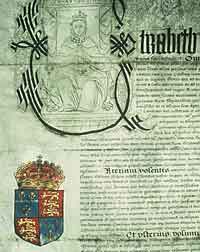
|
Gloucester was given the formal
status of a port by letters patent from Queen Elizabeth I in 1580.
From that time, the coastline of the Severn estuary north-east of
the Aust/Beachley area came under the jurisdiction of a new custom
house at Gloucester. This meant that vessels could trade directly
between Gloucester and foreign ports without having to call in at
Bristol custom house, which had previously been responsible for
the area. Gloucester Corporation hoped to benefit from the new status
because they collected dues on goods handled at Gloucester's riverside
Quay. In practice, however, few foreign-going vessels were seen
at the Quay because of the difficulties of navigating the shallow
tidal stretch of the River Severn approaching the city.
The opening of the Gloucester & Sharpness Canal in 1827 allowed
ships to bypass the difficult stretch of river, and so considerable
trade developed with foreign ports. To supervise this better, a
new custom house was built in the docks area in 1845. After the
new dock at Sharpness was opened in 1874 to accommodate the larger
ships then in use, cargo handling activities gradually declined
at Gloucester, and in due course customs administration moved to
Sharpness. |
